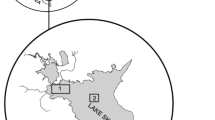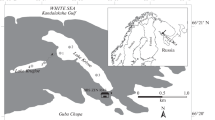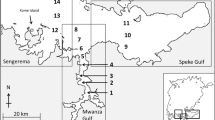Abstract
Growth patterns and food composition of perch, Perca fluviatilis L., was studied in two small forest lake populations in southern Finland. Size and morphometry of the lakes and physical and chemical properties of water are similar. There is a clear difference in the growth rates of perch between the two lakes. The difference in growth is highly significant in all age groups. In the first lake there is a perch population of 2 000 (1750 ind · ha−1) adult fishes. In the second lake there is a small population of pike, that keeps the perch population down: 200 adult perch (530 ind · ha-1). The main food items of perch are crustacean zooplankton, Asellus aquaticus L. and Trichoptera larvae in the first lake and zooplankton, Odonata larvae, Ephemeroptera larvae and Heteroptera in the second.
It is concluded that the main reason for the growth difference of studied perch populations is the different population density. There are also differences in species composition of bottom fauna of the lakes, maybe owing to the floating Sphagnum peat moss vegetation in the second lake. This can also affect the growth difference between the two populations of perch.
Similar content being viewed by others
References
Alm, G., 1946. Reasons for the occurrence of stunted fish populations with special reference to the perch. Rep. Inst. freshwat. Res. Drottningholm 25, 146 pp.
Alm, G., 1959. Connection between maturity, size and age in fishes. Rep. Inst. freshwat. Res. Drottningholm 40: 5–145.
Arvola, L., in press. Seasonal succession of phytoplankton in two small, polyhumic forest lakes in S. Finland.
Craig, J. F., Kipling, C., Le Cren, E. D. & McCormack, J. C., 1979. Estimates of the numbers, biomass and year-class strengths of perch (Perca fluviatilis L.) in Windermere from 1967 to 1977 and some comparisons with earlier years. J. anim. Ecol. 48: 315–325.
Deelder, C. L., 1951. A contribution to the knowledge of the stunted growth of perch (Perca fluviatilis L.) in Holland. Hydrobiologia 3: 357–378.
Elrod, J. H., Busch, W.-D. N., Griswold, B. L., Schneider, C. P. & Wolfert, D. R., 1981. Food of white perch, rock bass and yellow perch in eastern Lake Ontario. N. Y. Fish Game J. 28: 192–201.
Hartmann, J., 1975. Der Barsch (Perca fluviatilis) im eutrophierten Bodensee. Arch. Hydrobiol. 76: 269–286.
Jellyman, D. J., 1980. Age, growth, and reproduction of perch, Perca fluviatilis L., in Lake Pounui. N. Z. J. mar. freshwat. Res. 14: 391–400.
Kitchell, J. F., Johnson, M. G., Minns, C. G., Loftus, K. H., Greig, L. & Olver, C. H., 1977. Percid habitat: The river analogy. J. Fish. Res. Bd Can. 34: 1936–1940.
Koli, L., Aro, E. & Rask, M., 1978. Tvärminnen ahvenen populaatiotutkimus. Loppuraportti Suomen Akatemian luonnontieteelliselle toimikunnalle. A preliminary research report (in Finnish). Helsinki. 12 pp.
Le Cren, E. D., 1947. The determination of the age and growth of the perch (Perca fluviatilis) from the opercular bone. J. anim. Ecol. 16: 188–204.
Macan, T. T., 1962. Ecology of aquatic insects. Ann. Rev. Ent. 7: 261–288.
Neuman, E., 1976. The growth and year-class strength of perch (Perca fluviatilis L.) in some Baltic archipelagoes, with special reference to temperature. Rep. Inst. freshwat. Res. Drottningholm 55: 51–70.
Nyberg, P., 1976. Production and food consumption of perch in two Swedish forest lakes. Scripta Limnol. Ups. 421, Klotenprojektet Rap. 6: 1–97.
Pajunen, V. I., 1977. Population structure in rock-pool corixids (Hemiptera, Corixidae) during the reproductive season. Ann. zool. fenn. 14: 26–47.
Popova, O. A. & Sytina, L. A., 1977. Food and feeding relations of Eurasian perch (Perca fluviatilis) and pikeperch (Stizostedion lucioperca) in various waters of the USSR. J. Fish. Res. Bd Can. 34: 1559–1570.
Sumari, O., 1971. Structure of the perch populations of some ponds in Finland. Ann. zool. fenn. 8: 406–421.
Tesch, F.-W., 1955. Das Wachstum des Barsches (Perca fluviatilis L.) in verschiedenen Gewässern. Z. Fisch. 4: 321–420.
Thorpe, J. E., 1977. Morphology, physiology, behaviour, and ecology of Perca fluviatilis L. and P. flavescens Mitchell. J. Fish. Res. Bd Can. 34: 1504–1514.
Viljanen, M., 1978. Population studies of vendace (Coregonus albula L.) and perch (Perca fluviatilis L.) in a mesohumic oligotrophic lake. Verh. int. Ver. Limnol. 20: 2103–2110.
Author information
Authors and Affiliations
Rights and permissions
About this article
Cite this article
Rask, M. Differences in growth of perch (Perca fluviatilis L.) in two small forest lakes. Hydrobiologia 101, 139–143 (1983). https://doi.org/10.1007/BF00008666
Issue Date:
DOI: https://doi.org/10.1007/BF00008666




